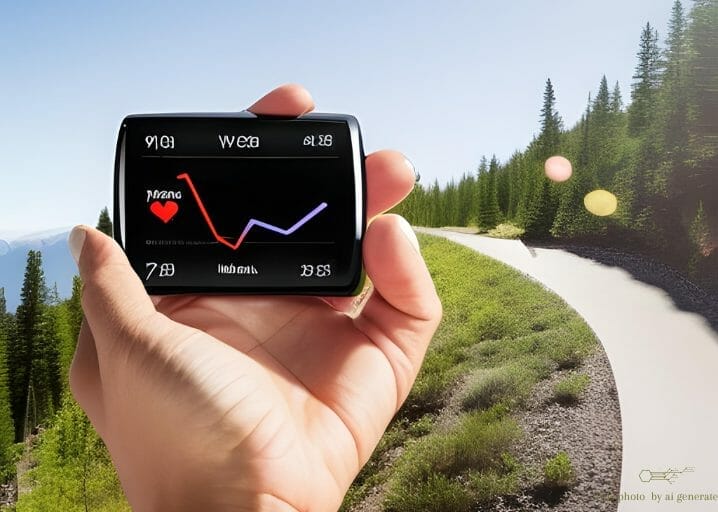In today’s fast-paced world, people are increasingly conscious of their health and fitness levels. One of the most popular ways to stay on top of your fitness goals is by using a heart rate monitor. These monitors help you keep track of your heart rate during exercise, allowing you to optimize your workouts and achieve your fitness goals more efficiently.
However, with so many different types of heart rate monitors available, it can be challenging to know which one to choose.
In this comprehensive guide, we will take you through the different categories of heart rate monitors available, the features and technology they offer, and how to choose the right one for your needs and budget. We will also provide reviews of other exercise equipment and offer tips on exercises for those with knee problems and the benefits of walking on an incline.
By the end of this guide, you will have a thorough understanding of heart rate monitors and be able to make an informed decision when purchasing one.
So, let’s dive in and explore how to buy a heart rate monitor: a comprehensive guide.
Key Takeaways
Heart Rate Monitor Categories
Heart rate monitors are categorized into three types: chest strap, watch, and activity tracker. Each of these categories has its own advantages and limitations.
Chest strap monitors are known for their accuracy, as they detect electrical pulses generated by the heart. However, they are uncomfortable to wear and need to remain wet for accurate readings.
Watch monitors are more convenient than chest strap monitors, but they are less accurate as they measure heart rate optically at the wrist using light.
On the other hand, activity trackers offer additional features beyond heart rate monitoring, such as step counting, calorie tracking, and exercise time monitoring.
When it comes to exercise, some people prefer using an activity tracker over a heart rate monitor, while others swear by heart rate monitors during workouts. Activity trackers can be useful for assessing resting heart rate during the day, while heart rate monitors designed for exercise are better for determining recovery time.
However, if accuracy is a top priority, chest strap monitors are the way to go. Ultimately, the choice between an activity tracker and a heart rate monitor for exercise is a matter of personal preference and needs.
Features and Technology
Activity trackers offer additional features beyond heart rate monitoring, such as step counting, calorie tracking, and exercise time monitoring. These devices are ideal for those who want to track their overall fitness and health, with the added benefit of heart rate monitoring during exercise. Some activity trackers even offer advanced features like sleep tracking, which can help users understand their sleep patterns and improve their sleep quality.
Another important feature to consider when purchasing a heart rate monitor is GPS technology. This feature allows users to track their distance, pace, and route during outdoor activities like running or cycling. GPS-enabled heart rate monitors are especially useful for those who enjoy outdoor activities and want to track their progress over time. Additionally, accuracy improvements in heart rate monitoring technology have made these devices more reliable and accurate than ever before. With the ability to monitor heart rate throughout the day and during exercise, users can gain valuable insights into their overall health and fitness.
Choosing the Right HRM
One of the crucial decisions to make when selecting a heart rate monitor is determining the specific functions and features that align with your exercise routine and fitness goals.
For instance, if you are interested in understanding heart rate zones, you may opt for a monitor that has a zone training feature. Additionally, if you want to track your heart rate throughout the day, an activity tracker with heart rate monitoring capabilities may be more suitable.
When considering HRM brands, some reputable options include Garmin, Polar, Fitbit, and Wahoo.
It is also important to consider the accuracy of the heart rate monitor. If you are looking for extra accuracy, a chest strap monitor may be the best option. However, if comfort is a priority, a watch or activity tracker may work better for you.
Other factors to consider include whether you want GPS capabilities, water resistance for swimming, or additional features such as sleep tracking.
Ultimately, it is essential to assess your needs and preferences before making a purchase to find the HRM that best fits your lifestyle and fitness goals.
Additional Exercise Equipment and Tips
The article also provides reviews and recommendations for various exercise equipment, as well as tips for modifying your workout routine to accommodate injuries such as bad knees.
For those looking for low-impact exercise options, the Horizon 5.0U Upright Bike may be a good choice. This bike offers a comfortable and adjustable seat, multiple resistance levels, and a variety of workout programs.
Additionally, AtivaFit’s Adjustable Dumbbell Set is a versatile and space-saving option for strength training at home. With adjustable weights ranging from 5 to 25 pounds, this set allows for a variety of exercises without the need for multiple sets of dumbbells.
For individuals with knee issues, the article offers tips on knee-friendly workouts. Walking on an incline is a good option for cardio without putting too much pressure on the knees. Additionally, exercises such as swimming, cycling, and yoga can be modified to be more knee-friendly.
Strengthening the muscles around the knees through exercises such as leg presses and squats can also help alleviate knee pain. By incorporating these exercise options and modifications, individuals can still maintain an active lifestyle while accommodating their injuries.
Frequently Asked Questions
What is the average lifespan of a heart rate monitor?
The average lifespan of a heart rate monitor depends on its durability and maintenance. With proper care and upkeep, most heart rate monitors can last for several years. Factors such as battery life and wear and tear can also impact longevity.
How often should the battery be replaced in a heart rate monitor?
The battery lifespan of a heart rate monitor varies depending on usage and model, but replacement frequency is typically every 6-12 months. Some models may have replaceable batteries, while others require professional servicing.
Can heart rate monitors be worn during water activities such as scuba diving?
Despite the possibility of water damage, heart rate monitors can be worn during water activities with water-resistant options. However, accuracy and reliability may be affected, so it’s important to choose a suitable model.
Are there any heart rate monitors specifically designed for people with pacemakers?
Heart rate monitors designed for pacemaker compatibility are available. However, their accuracy and reliability may be affected by the presence of the pacemaker. It is important to consult with a healthcare provider before using a heart rate monitor with a pacemaker.
How do heart rate monitors differ from electrocardiogram (ECG) machines?
Heart rate monitors are portable devices that measure and display heart rate, while ECG machines are medical devices that monitor and record heart activity. ECGs have higher accuracy in detecting heart conditions, while heart rate monitor accuracy can vary depending on the device.
Conclusion
Heart rate monitors are a valuable tool for those looking to track their fitness levels and optimize their workouts. With a variety of options available, it can be challenging to know which one to choose.
This comprehensive guide has explored the different types of heart rate monitors, their features and benefits, and provided advice on how to select the right one for your needs and budget. Additionally, we have offered reviews of other exercise equipment and tips on exercises for those with knee problems and walking on an incline.
In conclusion, selecting the right heart rate monitor can be compared to choosing the right tool for a job. Just as a carpenter must select the appropriate tool for each task, so too must an individual select the right heart rate monitor to achieve their fitness goals. By considering factors such as heart rate monitor categories, features and technology, and personal needs and budget, individuals can make an informed decision and use their heart rate monitor as a valuable tool in their fitness journey.




